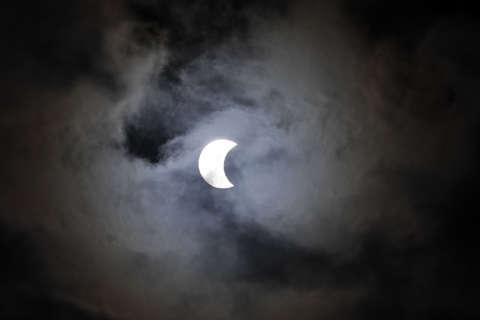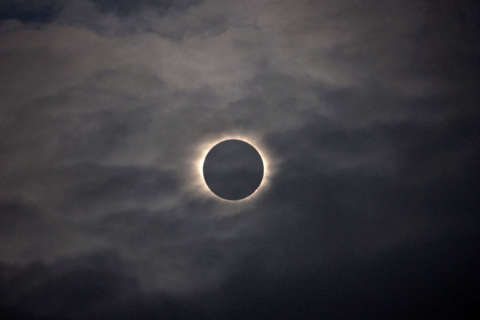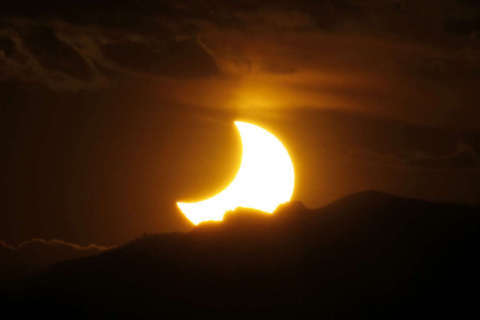WASHINGTON — As the 2017 solar eclipse approaches, here’s a look at how the weather could impact eclipse viewing in the D.C. area.
When and where?
Starting at 10:16 a.m. Pacific Daylight Time along the Oregon coast on Aug. 21, skies will go dark as the solar eclipse gets underway.
It will continue to travel over U.S. land for more than 3,000 miles, moving across Idaho Falls, Idaho; Casper, Wyoming; Nebraska, Missouri, southern Illinois, Kentucky and Tennessee, before it exits off the coast of South Carolina at 2:48 p.m. Eastern Daylight Time about 90 minutes after it first makes its appearance in Oregon.
This track will be the path of totality where tens of millions of Americans will be able to view it across about a 70-mile wide path. If you are not in the path of totality, you will still be able to see the eclipse but it will be partial. Only in the path of totality will it be safe to briefly take protective glasses off and watch with the naked eye.
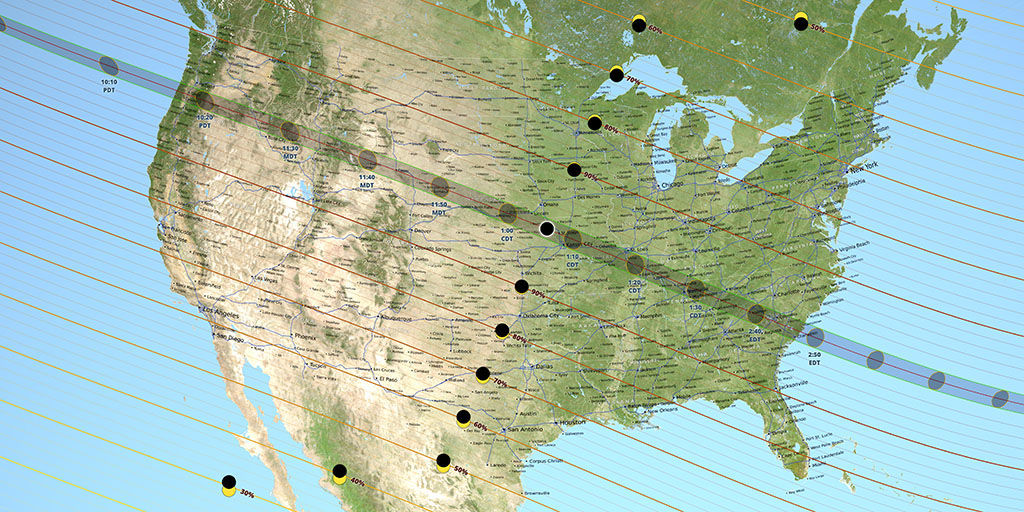
What is a solar eclipse?
What is a total solar eclipse? First off, the sun and moon give the illusion that they are the same size in the sky from the perspective of us here on Earth. However, the sun is 400 times larger than the moon and the moon is 400 times closer to the Earth than the sun. From time to time, the two will cross paths and the sun and the moon’s orbital plane perfectly intersect, which in turn creates a shadow outline of the sun as the moon passes in front of the sun. If you are in the path of totality, the moon will completely block out the sun.
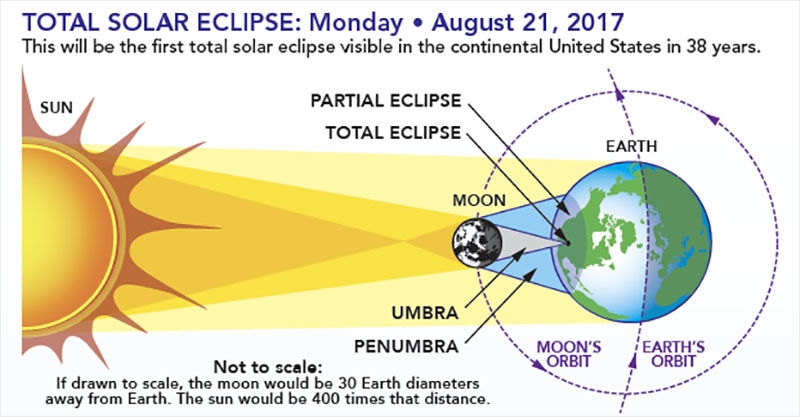
Weather will have a huge impact on what you see! We need to have clear conditions or at the very least, partly cloudy sky cover.
So, what will the weather be like on Monday?
Early indications are that conditions will be partly cloudy across the WTOP listening area. Therefore, we may have a few clouds out there for viewing but not a complete coverage of cloud cover. It’s largely expected to be mostly sunny with passing clouds. There will be a slight break in the humidity over the weekend (still muggy but not AS muggy as Friday)….however, humidity returns Monday.
A frontal system will be to the south, draped over the Carolinas. High pressure looks to build into the region moving southwest to northeast. If it scoots too far north on Monday, we could draw some moisture into the region from the water off the East Coast, banking clouds up against the mountains. However, for now, it looks to be partly cloudy in the region. Let’s hope it stays that way.
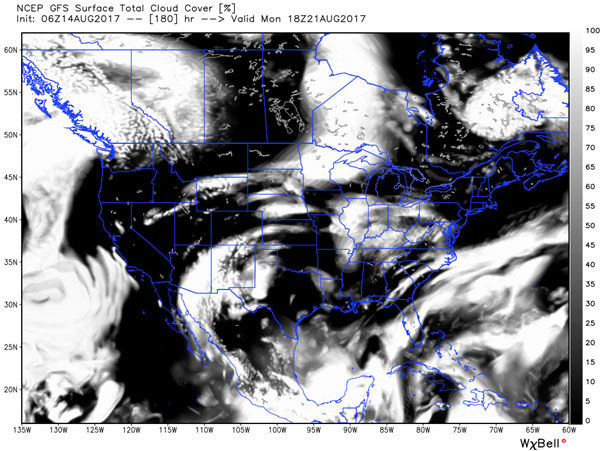
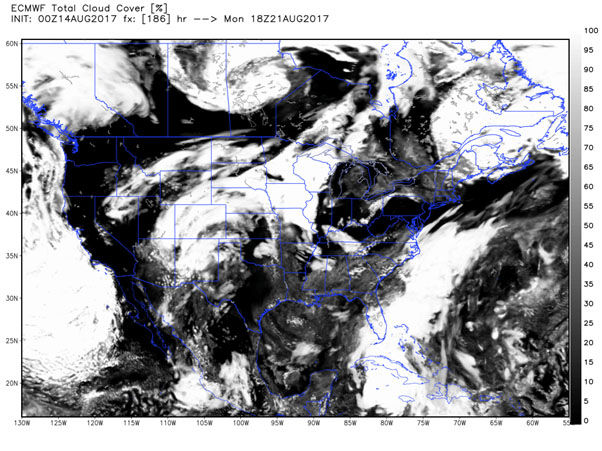
Why is it such a big deal?
Well, the last time a total solar eclipse occurred across the contiguous U.S. was on Feb. 26, 1979.
The path of that eclipse passed through the northwestern U.S. states (Washington, Oregon, Idaho, Montana, North Dakota.) Before 1979, it was 1918 when a total solar eclipse went from one coast to the other coast, traveling across the continental United States.
It has been 117 years since the last total solar eclipse in Virginia. The last total solar eclipse there was May 28, 1900.
The next solar eclipse in Virginia will be Sept. 14, 2099 — 82 years from now.
If you live in the District, the last total eclipse was 539 years ago in 1478. The next time the path of totality will cross through D.C. will be in 183 years, on 4/14/2200.
Parts of Maryland (southern portion of the Eastern Shore) experienced a total solar eclipse on March 7, 1970. Similar to the District, the next chance to see a total solar eclipse in Maryland will be in 183 years on 4/14/2200.
What can you expect to see, what time and for how long?
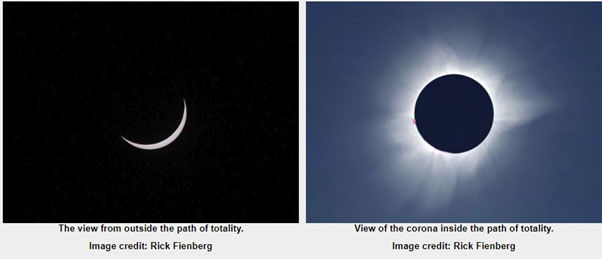
The Maryland, Virginia and D.C. area will experience a partial eclipse, because the area is not in the path of totality.
So, let’s break it down.
The partial eclipse in this region will begin around 1:17 p.m. Aug. 21. The moon will begin covering the sun’s surface by that time. By 2:42 p.m., you will see the maximum amount of sun covered by the moon — 81 percent of the sun will be covered. At 4:01 p.m., the partial eclipse will end as the moon moves out of the path of the sun.
What else will happen during the solar eclipse?
For those in the path of totality, temperatures will drop and the winds could even pick up. Animals and insects may become confused. Small animals may even start acting strange. Wildlife experts say that birds will returns to their nests and fall silent.
How to view?
You will not need a telescope, first and foremost. The only way to safely view the uneclipsed or partially eclipsed sun is through special-purpose eclipse glasses or hand-held solar viewers. Homemade filters or ordinary sunglasses are not a safe way to look directly at the sun.
To date, three manufacturers have certified that their eclipse glasses meet international standards for such products: Rainbow Symphony, American Paper Optics and Thousand Oaks Optical. These companies may be found online. Again, make sure you buy ones that are NASA-approved.
Why is it not safe to look at the sun even when only a small part of it is visible?
Here’s the official explanation from NASA:
“The rods and cones in the human retina are very sensitive to light. Even a thin sliver of the sun’s disk covers thousands of these light-sensitive cells. Normally during daylight conditions, the iris contracts so that only a small amount of light passes through the lens and then reaches the retina. This level of indirect sunlight is perfectly OK and the eye has evolved over millions of years to safely see the daylight world under most circumstances. The problem is that the sun’s surface is so bright that if you stare at any portion of it, no matter how small, it produces enough light to damage individual retinal cells. It takes a few seconds for this to happen, but afterward you will see a spot as big as the solar surface you glimpsed when you look away from the sun at some other scenery. Depending on how long you gazed at the sun and how badly the retinal cells were damaged, this spot will either fade away in time or remain permanent. You should never assume that you can look away quickly enough to avoid eye damage because every person is different in terms of their retinal sensitivity, and you do not want to risk being the one who damages their eyes just to try to look at the sun.”
More: The 2017 solar eclipse: Everything you need to know

